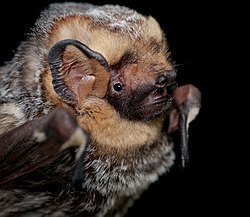| Hairy-tailed bats | |
|---|---|
 | |
| Hoary bat (Lasiurus cinereus) | |
| Scientific classification | |
| Kingdom: | Animalia |
| Phylum: | Chordata |
| Class: | Mammalia |
| Order: | Chiroptera |
| Family: | Vespertilionidae |
| Tribe: | Lasiurini |
| Genus: | Lasiurus Gray, 1831 |
| Type species | |
| Vespertilio borealis (Müller, 1776) | |
| Species | |
20, see text. | |
Lasiurus is a genus of bats in the family Vespertilionidae. Its members are known as hairy-tailed bats or red bats. [1]